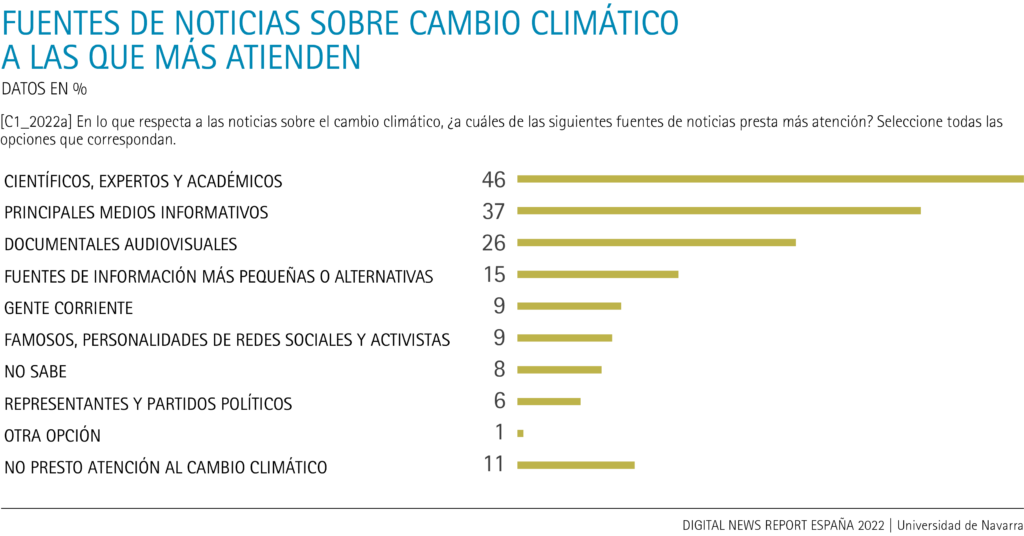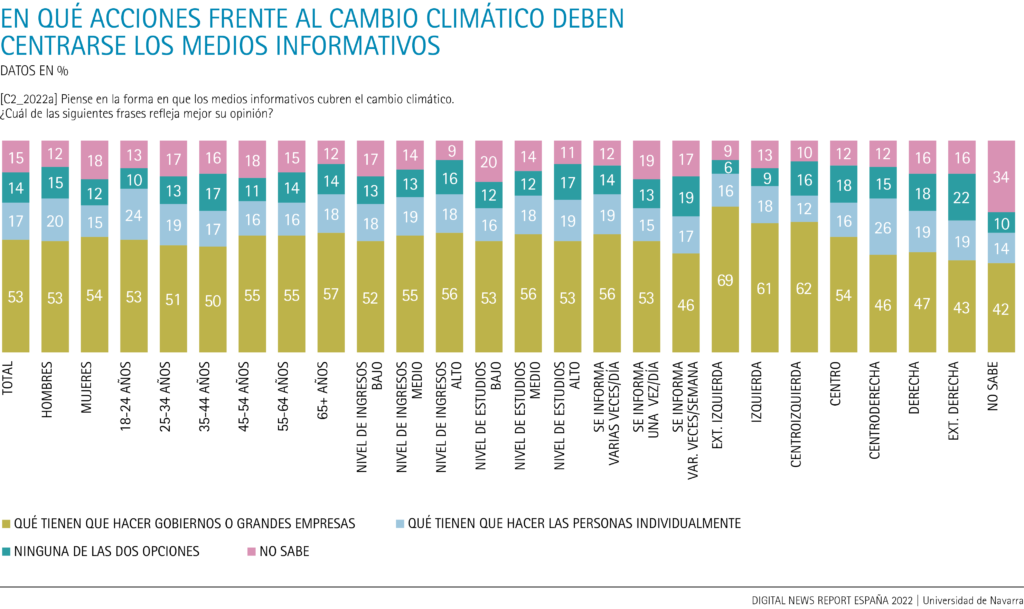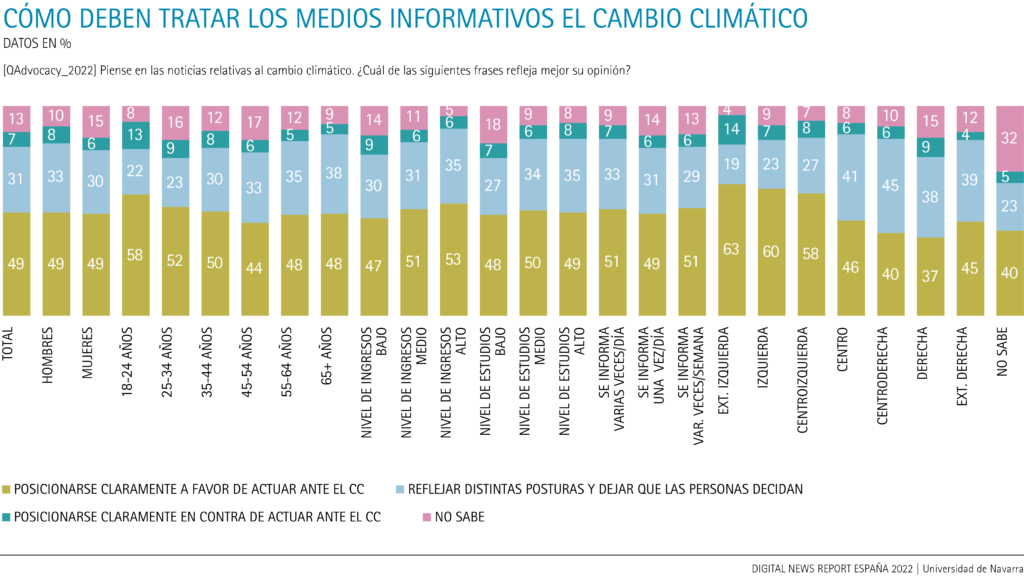-
The older, wealthier, more affluent, Education regulated or closer to the political center the users are, the more attention is paid to them.
-
Celebrities, social network personalities and activists are a minority source (9%) with profile opposite to the previous ones: they reach somewhat more young people, with lower income and level educational, and at the political extremes.
-
We learn about climate change from mainstream media (37%), audiovisual documentaries (26%) and smaller or alternative sources (15%).
-
53% believe that the media should focus on what governments or large companies should do about climate change, compared to 17% who point to what individuals should do at degree scroll .
-
Nearly half of adults believe that the media should take a clear position in favor of taking action on climate change (49%).
-
This opinion is more prevalent among people on the left (61%), and those on the right are divided between taking sides in this way (39%) or reflecting both positions, acting or not (39%).
Scientists, experts and academics (46%) are one of the main sources of information on climate change for all subject audiences; to a greater extent, the older, wealthier, with Education regulated or close to the political center are the users.
Thus, 60% of people over 65 years of age, 60% of people with high incomes, 56% of people with higher programs of study or 50% of people in the center, including the center-left and center-right, pay attention to this source subject in relation to climate change.
Celebrities, social network personalities and activists are a minority source (9%) with profile opposite to the previous ones: they reach to a greater extent young people (at 22% between 18 and 24 years old, and 14% between 25 and 34 years old), people with less income (11%), and at the political poles (15% on the extreme left and 14% on the extreme right).
With a few tenths of a percentage point more, but still at 9%, are ordinary people, a source of information for whom there are no significant sociodemographic, ideological or frequency of information consumption differences.
Finally, political representatives and political parties (6%) are more attended to in relation to climate change by men (8%) than by women (4%); by young people aged 18 to 24 (11%), by people with higher income, programs of study and frequency of information consumption (8% in all three cases), and by people from extreme left to center-right (7%).
Mainstream media, documentaries and alternative sources
As for the types of sources on climate change that can be included in the media structure, and remembering that the participants could select several options, the main news media predominate, with a reach of 37%, very similar between men and women. Acceptance varies according to age: it is 31% in adults under 45 years of age, and 41% above this age.
The consumption of climate change information in the mainstream media also bears some proportion with the level of income (from 35% to 42%) or the level educational (from 34% to 40%), and especially with the frequency of information consumption, between 43% and 22% for the groups we usually manage: informing several times a day or not every day but several times a week, while those who inform themselves daily are in the average in the attention to the mainstream media on the issue of climate change; at that 37%.
There are other relevant sources. One in four adults who go online say they pay attention to audiovisual documentaries to learn more about climate change (26%). Among people under 45 years of age, we are talking about rather one in five (20%). In the 45-54 age group (24%), they are closer to average and to the proportion mentioned at the beginning of this paragraph. Finally, it is people aged 55 and over who pay the most attention to climate change documentaries: one in three (32%). These productions especially reach people with high incomes (29%), who are informed once a day (29%), and located on the left or center-left (32%).
On the other hand, smaller or alternative sources of information regarding climate change reach 15% in total, more men (17%) than women (13%), with those under 45 years of age above the average (18%), especially those under 35 (20%). People who do not inform themselves on a daily basis also pay comparatively more attention to them than others (18%), as do people on the far left (35%), left (16%), center-left (17%) and center (17%).
Who 'pass' on climate change
The Spanish public pays attention to news about climate change in a very large majority: eight out of ten people. Those who say they do not pay attention to climate change are only 11% of adults connected to the Internet, and only 7% in groups such as young people aged 18 to 24. This disinterest is only detected, to a slightly greater extent, among people on the center-right (16%), right (20%) or extreme right (24%), but in all these groups there are considerably more who pay attention to categories such as experts, scientists and academics, or the mainstream media.

Focus on governments and corporations or on individual action
53% believe that the media should focus on what governments or large companies should do about climate change, compared to 17% who point to what people should do at degree scroll individually, and 14% who say that the focus should not be on either side, a view that is more pronounced among right-wingers.
More advocating a focus on big power are people from across the left spectrum (61%), while men, at 20%; younger people (18-24), at 24%; and those who define themselves politically as center-right (26%) are the groups most encouraging the media to highlight what can be done as individuals against climate change.
In any case, regardless of gender, age, socioeconomic level or political affiliation, when deciding what the media's criteria should be, the attention that should be paid to the role of governments and large companies is almost three times greater than that of individuals.

Half support media positioning in favor of taking action
Forty-nine percent of adult Internet users in Spain support the media taking a clear position in favor of action on climate change. Among young people aged 18 to 24 this opinion reaches 58%, and people who identify themselves politically as left-wing estimate it at 61%.
Three in ten, 31%, believe that the media should reflect different positions on climate change and let people decide. Right-wing public opinion is split between the media taking sides in favor of action on climate change (39%) and this other option of reflecting both that position and no action (39%).
A small minority (7%) maintain that the media should take a clear position against taking action on climate change. Otherwise, there are no major differences in terms of socio-demographics or media consumption.
